Statistics Assignment: ANOVA, Regression, and Time Series Analysis
VerifiedAdded on 2020/05/16
|9
|1266
|352
Homework Assignment
AI Summary
This document presents a comprehensive statistics assignment solution, covering various statistical concepts and techniques. It includes detailed answers to problems involving ANOVA (Analysis of Variance), regression analysis, and time series forecasting. The assignment explores hypothesis testing, interpreting p-values, and determining statistical significance. Solutions are provided for calculating coefficients of regression equations, determining the number of groups and observations, and analyzing the relationship between variables. The document also addresses time series analysis, including simple moving averages and mean square error calculations, as well as the coefficient of determination and the interpretation of regression models. The assignment covers a wide range of statistical methods, providing a thorough understanding of data analysis and interpretation. It analyzes data from different scenarios, like sales, mileage, and stock prices, to provide practical application of the concepts.
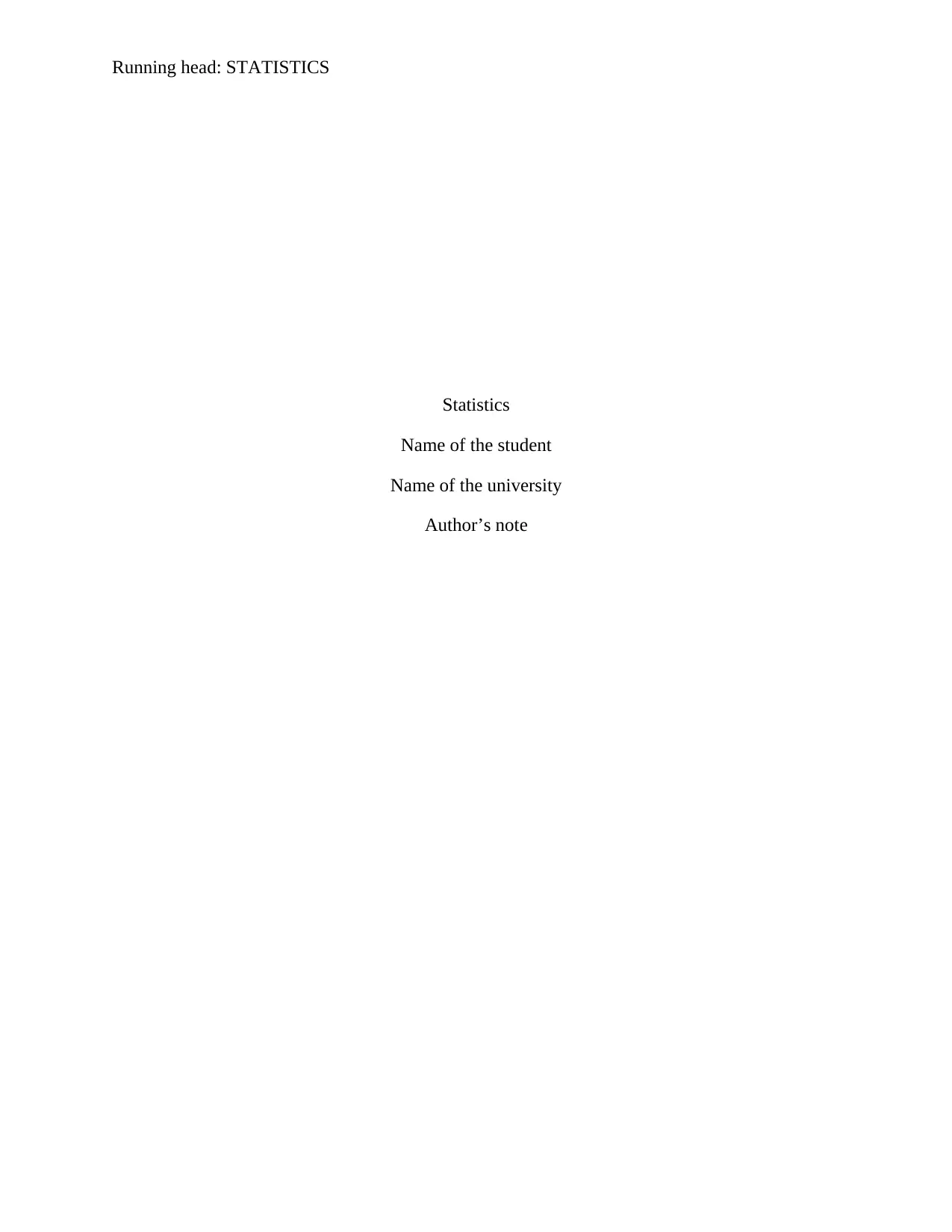
Running head: STATISTICS
Statistics
Name of the student
Name of the university
Author’s note
Statistics
Name of the student
Name of the university
Author’s note
Paraphrase This Document
Need a fresh take? Get an instant paraphrase of this document with our AI Paraphraser
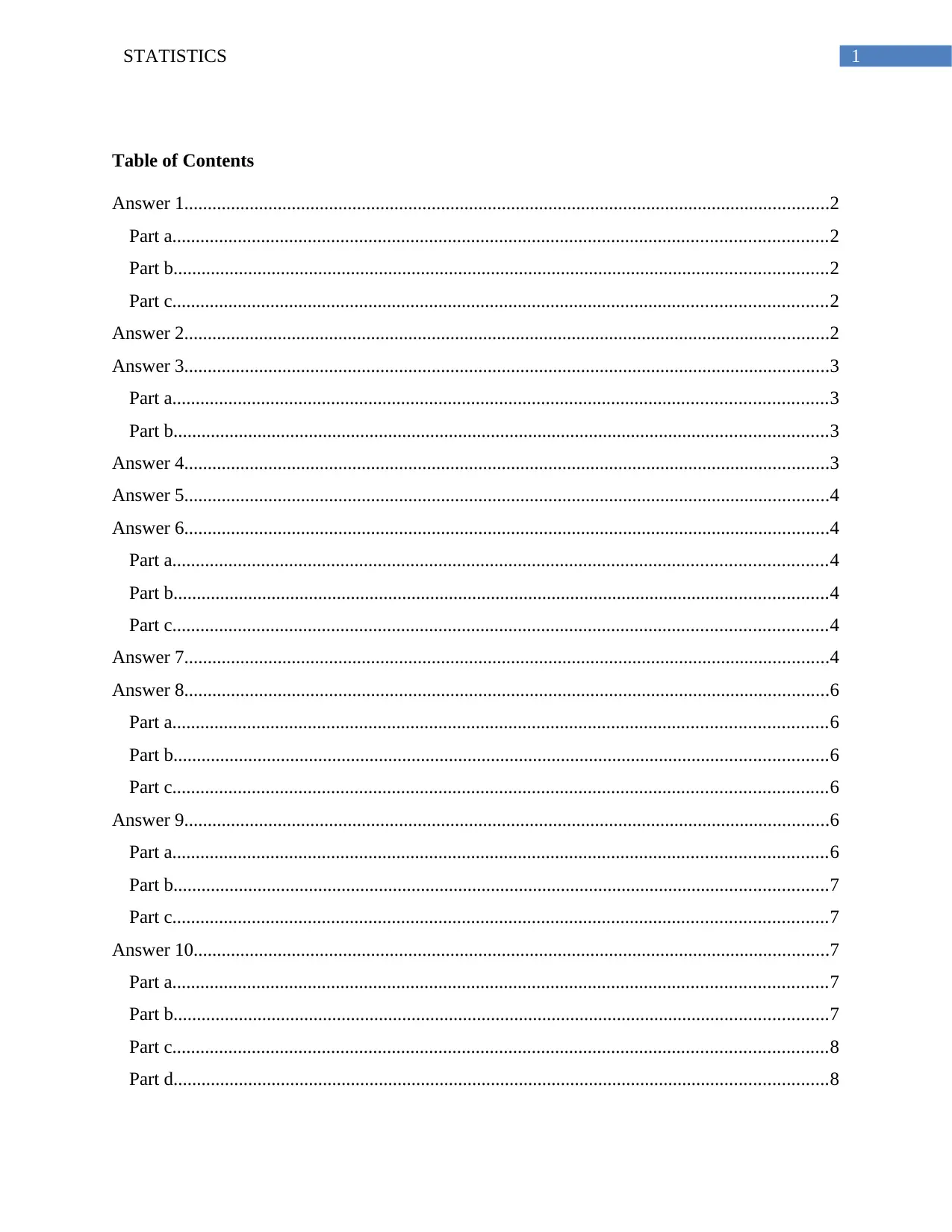
1STATISTICS
Table of Contents
Answer 1..........................................................................................................................................2
Part a............................................................................................................................................2
Part b............................................................................................................................................2
Part c............................................................................................................................................2
Answer 2..........................................................................................................................................2
Answer 3..........................................................................................................................................3
Part a............................................................................................................................................3
Part b............................................................................................................................................3
Answer 4..........................................................................................................................................3
Answer 5..........................................................................................................................................4
Answer 6..........................................................................................................................................4
Part a............................................................................................................................................4
Part b............................................................................................................................................4
Part c............................................................................................................................................4
Answer 7..........................................................................................................................................4
Answer 8..........................................................................................................................................6
Part a............................................................................................................................................6
Part b............................................................................................................................................6
Part c............................................................................................................................................6
Answer 9..........................................................................................................................................6
Part a............................................................................................................................................6
Part b............................................................................................................................................7
Part c............................................................................................................................................7
Answer 10........................................................................................................................................7
Part a............................................................................................................................................7
Part b............................................................................................................................................7
Part c............................................................................................................................................8
Part d............................................................................................................................................8
Table of Contents
Answer 1..........................................................................................................................................2
Part a............................................................................................................................................2
Part b............................................................................................................................................2
Part c............................................................................................................................................2
Answer 2..........................................................................................................................................2
Answer 3..........................................................................................................................................3
Part a............................................................................................................................................3
Part b............................................................................................................................................3
Answer 4..........................................................................................................................................3
Answer 5..........................................................................................................................................4
Answer 6..........................................................................................................................................4
Part a............................................................................................................................................4
Part b............................................................................................................................................4
Part c............................................................................................................................................4
Answer 7..........................................................................................................................................4
Answer 8..........................................................................................................................................6
Part a............................................................................................................................................6
Part b............................................................................................................................................6
Part c............................................................................................................................................6
Answer 9..........................................................................................................................................6
Part a............................................................................................................................................6
Part b............................................................................................................................................7
Part c............................................................................................................................................7
Answer 10........................................................................................................................................7
Part a............................................................................................................................................7
Part b............................................................................................................................................7
Part c............................................................................................................................................8
Part d............................................................................................................................................8
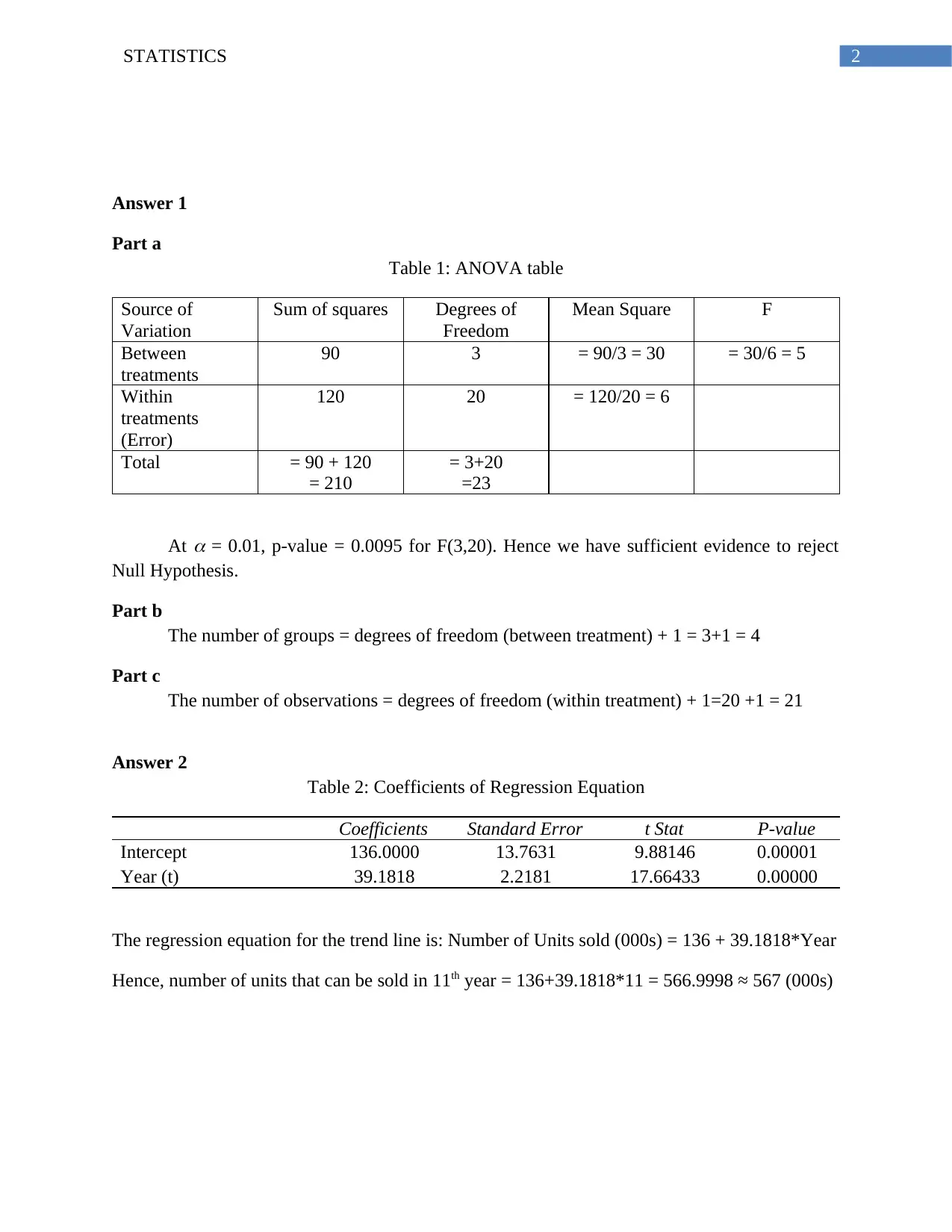
2STATISTICS
Answer 1
Part a
Table 1: ANOVA table
Source of
Variation
Sum of squares Degrees of
Freedom
Mean Square F
Between
treatments
90 3 = 90/3 = 30 = 30/6 = 5
Within
treatments
(Error)
120 20 = 120/20 = 6
Total = 90 + 120
= 210
= 3+20
=23
At
= 0.01, p-value = 0.0095 for F(3,20). Hence we have sufficient evidence to reject
Null Hypothesis.
Part b
The number of groups = degrees of freedom (between treatment) + 1 = 3+1 = 4
Part c
The number of observations = degrees of freedom (within treatment) + 1=20 +1 = 21
Answer 2
Table 2: Coefficients of Regression Equation
Coefficients Standard Error t Stat P-value
Intercept 136.0000 13.7631 9.88146 0.00001
Year (t) 39.1818 2.2181 17.66433 0.00000
The regression equation for the trend line is: Number of Units sold (000s) = 136 + 39.1818*Year
Hence, number of units that can be sold in 11th year = 136+39.1818*11 = 566.9998 ≈ 567 (000s)
Answer 1
Part a
Table 1: ANOVA table
Source of
Variation
Sum of squares Degrees of
Freedom
Mean Square F
Between
treatments
90 3 = 90/3 = 30 = 30/6 = 5
Within
treatments
(Error)
120 20 = 120/20 = 6
Total = 90 + 120
= 210
= 3+20
=23
At
= 0.01, p-value = 0.0095 for F(3,20). Hence we have sufficient evidence to reject
Null Hypothesis.
Part b
The number of groups = degrees of freedom (between treatment) + 1 = 3+1 = 4
Part c
The number of observations = degrees of freedom (within treatment) + 1=20 +1 = 21
Answer 2
Table 2: Coefficients of Regression Equation
Coefficients Standard Error t Stat P-value
Intercept 136.0000 13.7631 9.88146 0.00001
Year (t) 39.1818 2.2181 17.66433 0.00000
The regression equation for the trend line is: Number of Units sold (000s) = 136 + 39.1818*Year
Hence, number of units that can be sold in 11th year = 136+39.1818*11 = 566.9998 ≈ 567 (000s)
⊘ This is a preview!⊘
Do you want full access?
Subscribe today to unlock all pages.

Trusted by 1+ million students worldwide
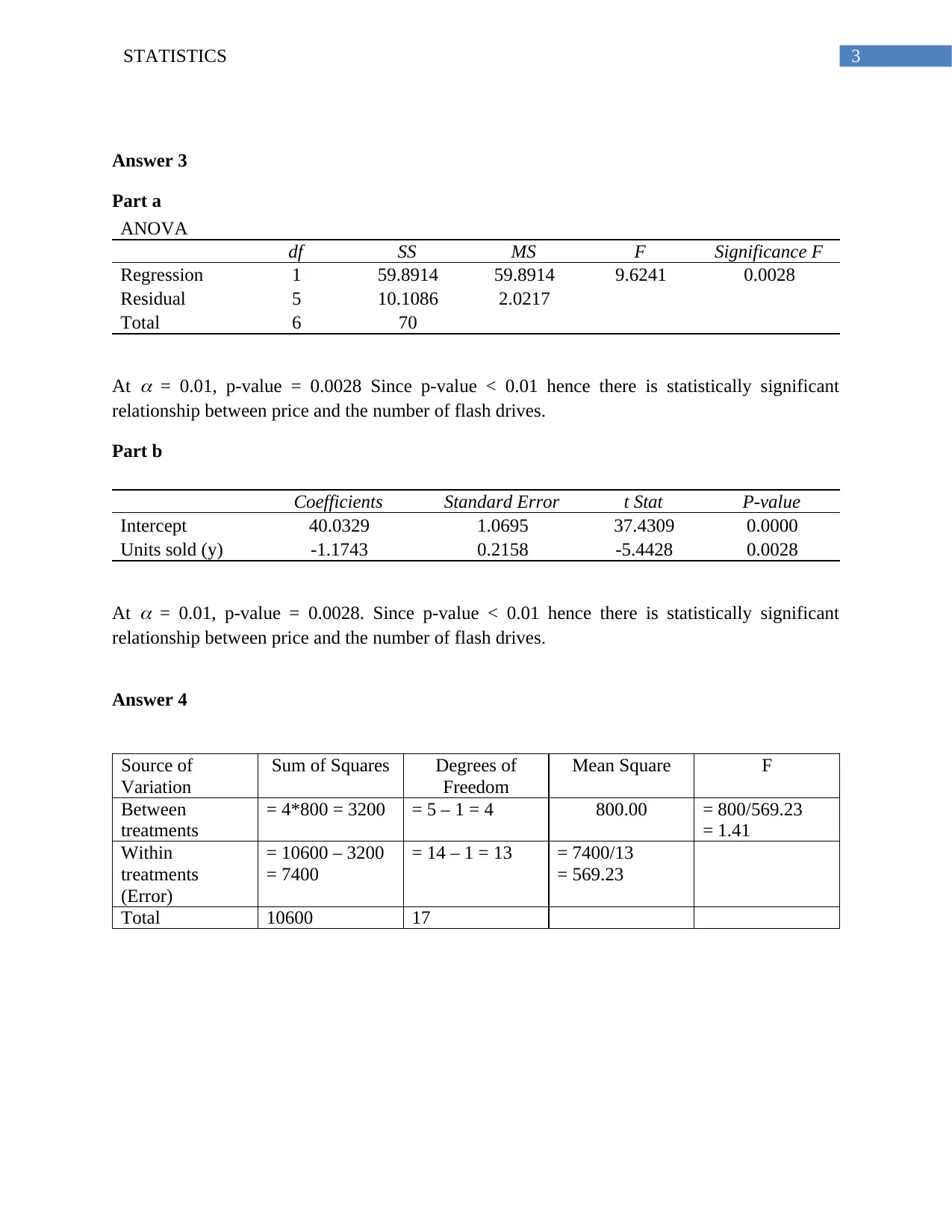
3STATISTICS
Answer 3
Part a
ANOVA
df SS MS F Significance F
Regression 1 59.8914 59.8914 9.6241 0.0028
Residual 5 10.1086 2.0217
Total 6 70
At
= 0.01, p-value = 0.0028 Since p-value < 0.01 hence there is statistically significant
relationship between price and the number of flash drives.
Part b
Coefficients Standard Error t Stat P-value
Intercept 40.0329 1.0695 37.4309 0.0000
Units sold (y) -1.1743 0.2158 -5.4428 0.0028
At
= 0.01, p-value = 0.0028. Since p-value < 0.01 hence there is statistically significant
relationship between price and the number of flash drives.
Answer 4
Source of
Variation
Sum of Squares Degrees of
Freedom
Mean Square F
Between
treatments
= 4*800 = 3200 = 5 – 1 = 4 800.00 = 800/569.23
= 1.41
Within
treatments
(Error)
= 10600 – 3200
= 7400
= 14 – 1 = 13 = 7400/13
= 569.23
Total 10600 17
Answer 3
Part a
ANOVA
df SS MS F Significance F
Regression 1 59.8914 59.8914 9.6241 0.0028
Residual 5 10.1086 2.0217
Total 6 70
At
= 0.01, p-value = 0.0028 Since p-value < 0.01 hence there is statistically significant
relationship between price and the number of flash drives.
Part b
Coefficients Standard Error t Stat P-value
Intercept 40.0329 1.0695 37.4309 0.0000
Units sold (y) -1.1743 0.2158 -5.4428 0.0028
At
= 0.01, p-value = 0.0028. Since p-value < 0.01 hence there is statistically significant
relationship between price and the number of flash drives.
Answer 4
Source of
Variation
Sum of Squares Degrees of
Freedom
Mean Square F
Between
treatments
= 4*800 = 3200 = 5 – 1 = 4 800.00 = 800/569.23
= 1.41
Within
treatments
(Error)
= 10600 – 3200
= 7400
= 14 – 1 = 13 = 7400/13
= 569.23
Total 10600 17
Paraphrase This Document
Need a fresh take? Get an instant paraphrase of this document with our AI Paraphraser
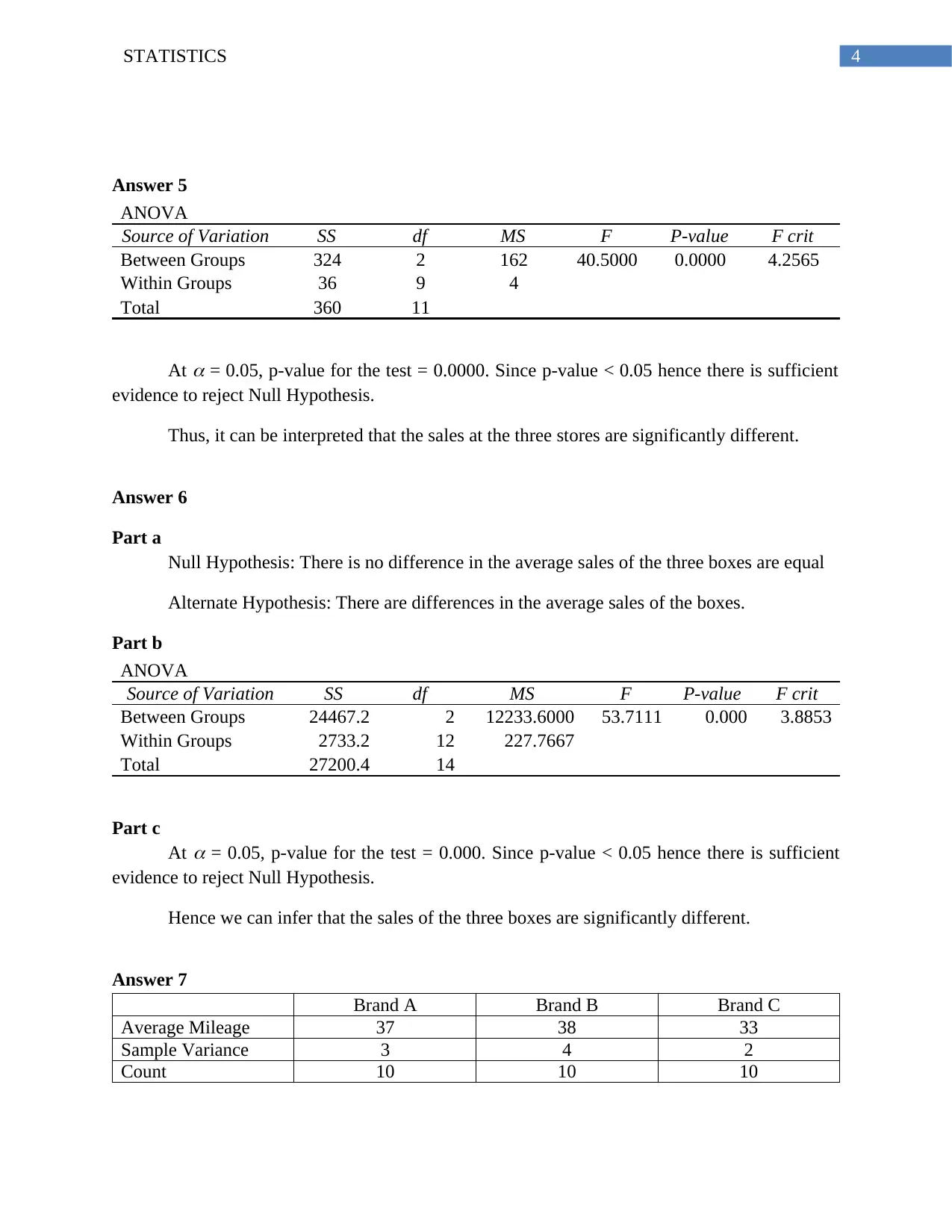
4STATISTICS
Answer 5
ANOVA
Source of Variation SS df MS F P-value F crit
Between Groups 324 2 162 40.5000 0.0000 4.2565
Within Groups 36 9 4
Total 360 11
At
= 0.05, p-value for the test = 0.0000. Since p-value < 0.05 hence there is sufficient
evidence to reject Null Hypothesis.
Thus, it can be interpreted that the sales at the three stores are significantly different.
Answer 6
Part a
Null Hypothesis: There is no difference in the average sales of the three boxes are equal
Alternate Hypothesis: There are differences in the average sales of the boxes.
Part b
ANOVA
Source of Variation SS df MS F P-value F crit
Between Groups 24467.2 2 12233.6000 53.7111 0.000 3.8853
Within Groups 2733.2 12 227.7667
Total 27200.4 14
Part c
At
= 0.05, p-value for the test = 0.000. Since p-value < 0.05 hence there is sufficient
evidence to reject Null Hypothesis.
Hence we can infer that the sales of the three boxes are significantly different.
Answer 7
Brand A Brand B Brand C
Average Mileage 37 38 33
Sample Variance 3 4 2
Count 10 10 10
Answer 5
ANOVA
Source of Variation SS df MS F P-value F crit
Between Groups 324 2 162 40.5000 0.0000 4.2565
Within Groups 36 9 4
Total 360 11
At
= 0.05, p-value for the test = 0.0000. Since p-value < 0.05 hence there is sufficient
evidence to reject Null Hypothesis.
Thus, it can be interpreted that the sales at the three stores are significantly different.
Answer 6
Part a
Null Hypothesis: There is no difference in the average sales of the three boxes are equal
Alternate Hypothesis: There are differences in the average sales of the boxes.
Part b
ANOVA
Source of Variation SS df MS F P-value F crit
Between Groups 24467.2 2 12233.6000 53.7111 0.000 3.8853
Within Groups 2733.2 12 227.7667
Total 27200.4 14
Part c
At
= 0.05, p-value for the test = 0.000. Since p-value < 0.05 hence there is sufficient
evidence to reject Null Hypothesis.
Hence we can infer that the sales of the three boxes are significantly different.
Answer 7
Brand A Brand B Brand C
Average Mileage 37 38 33
Sample Variance 3 4 2
Count 10 10 10
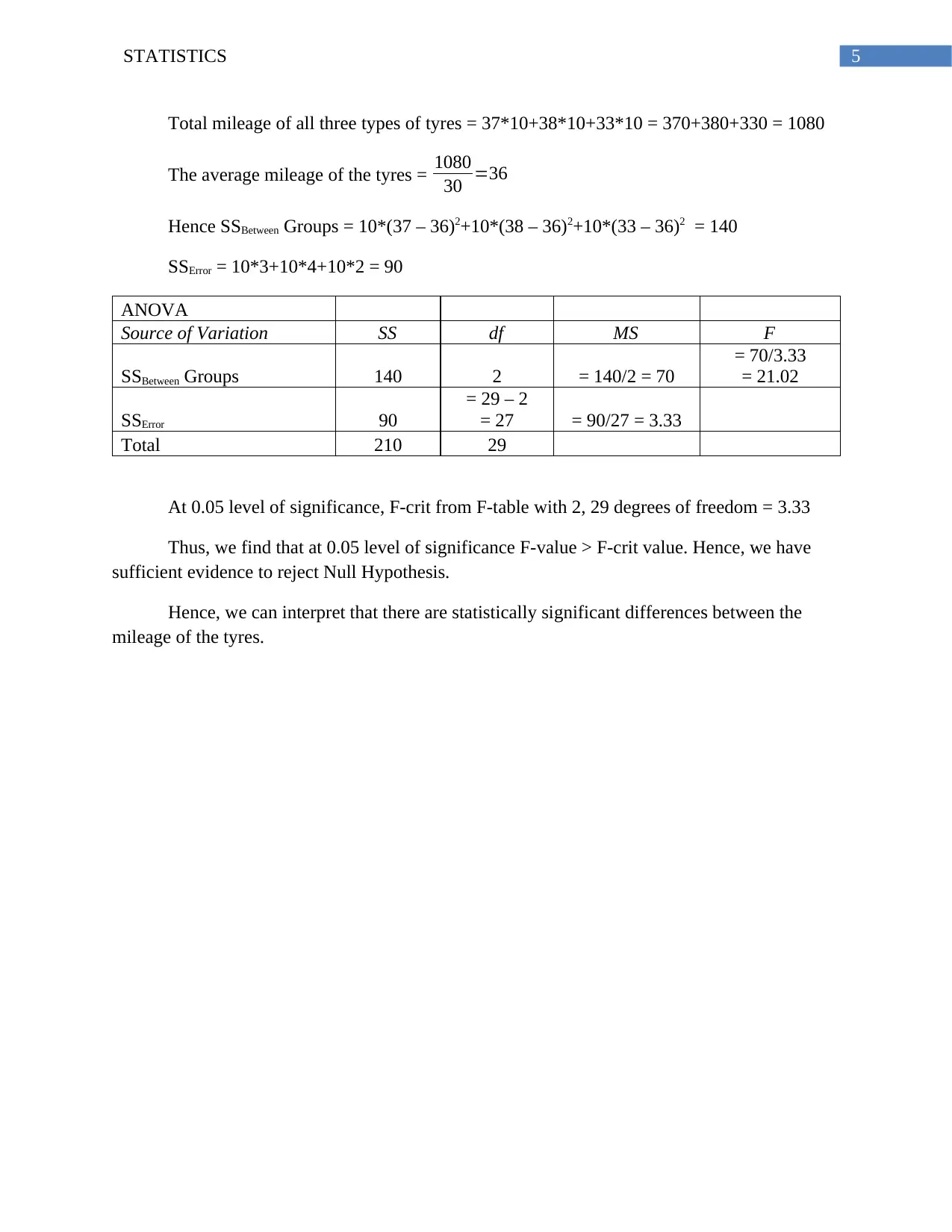
5STATISTICS
Total mileage of all three types of tyres = 37*10+38*10+33*10 = 370+380+330 = 1080
The average mileage of the tyres = 1080
30 =36
Hence SSBetween Groups = 10*(37 – 36)2+10*(38 – 36)2+10*(33 – 36)2 = 140
SSError = 10*3+10*4+10*2 = 90
ANOVA
Source of Variation SS df MS F
SSBetween Groups 140 2 = 140/2 = 70
= 70/3.33
= 21.02
SSError 90
= 29 – 2
= 27 = 90/27 = 3.33
Total 210 29
At 0.05 level of significance, F-crit from F-table with 2, 29 degrees of freedom = 3.33
Thus, we find that at 0.05 level of significance F-value > F-crit value. Hence, we have
sufficient evidence to reject Null Hypothesis.
Hence, we can interpret that there are statistically significant differences between the
mileage of the tyres.
Total mileage of all three types of tyres = 37*10+38*10+33*10 = 370+380+330 = 1080
The average mileage of the tyres = 1080
30 =36
Hence SSBetween Groups = 10*(37 – 36)2+10*(38 – 36)2+10*(33 – 36)2 = 140
SSError = 10*3+10*4+10*2 = 90
ANOVA
Source of Variation SS df MS F
SSBetween Groups 140 2 = 140/2 = 70
= 70/3.33
= 21.02
SSError 90
= 29 – 2
= 27 = 90/27 = 3.33
Total 210 29
At 0.05 level of significance, F-crit from F-table with 2, 29 degrees of freedom = 3.33
Thus, we find that at 0.05 level of significance F-value > F-crit value. Hence, we have
sufficient evidence to reject Null Hypothesis.
Hence, we can interpret that there are statistically significant differences between the
mileage of the tyres.
⊘ This is a preview!⊘
Do you want full access?
Subscribe today to unlock all pages.

Trusted by 1+ million students worldwide
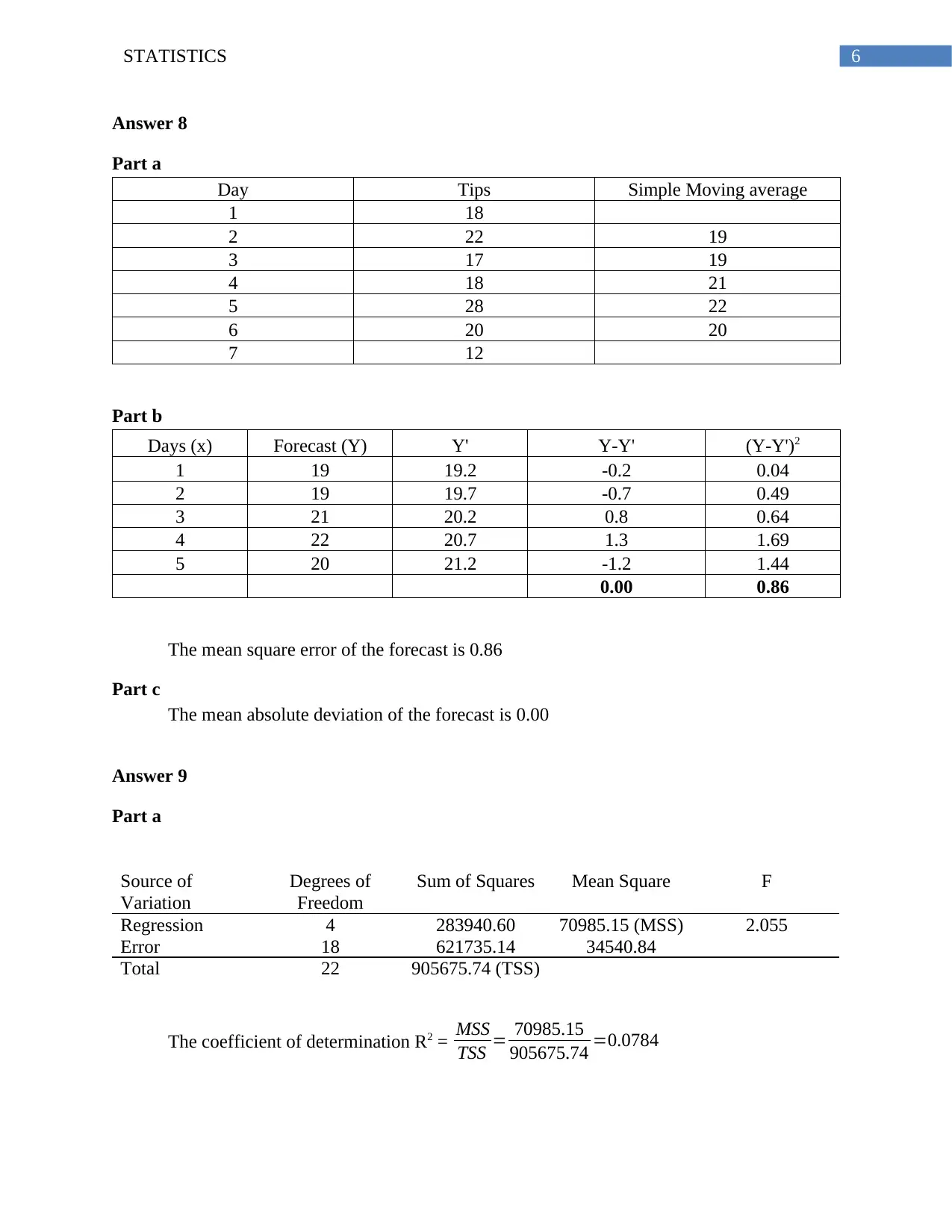
6STATISTICS
Answer 8
Part a
Day Tips Simple Moving average
1 18
2 22 19
3 17 19
4 18 21
5 28 22
6 20 20
7 12
Part b
Days (x) Forecast (Y) Y' Y-Y' (Y-Y')2
1 19 19.2 -0.2 0.04
2 19 19.7 -0.7 0.49
3 21 20.2 0.8 0.64
4 22 20.7 1.3 1.69
5 20 21.2 -1.2 1.44
0.00 0.86
The mean square error of the forecast is 0.86
Part c
The mean absolute deviation of the forecast is 0.00
Answer 9
Part a
Source of
Variation
Degrees of
Freedom
Sum of Squares Mean Square F
Regression 4 283940.60 70985.15 (MSS) 2.055
Error 18 621735.14 34540.84
Total 22 905675.74 (TSS)
The coefficient of determination R2 = MSS
TSS = 70985.15
905675.74 =0.0784
Answer 8
Part a
Day Tips Simple Moving average
1 18
2 22 19
3 17 19
4 18 21
5 28 22
6 20 20
7 12
Part b
Days (x) Forecast (Y) Y' Y-Y' (Y-Y')2
1 19 19.2 -0.2 0.04
2 19 19.7 -0.7 0.49
3 21 20.2 0.8 0.64
4 22 20.7 1.3 1.69
5 20 21.2 -1.2 1.44
0.00 0.86
The mean square error of the forecast is 0.86
Part c
The mean absolute deviation of the forecast is 0.00
Answer 9
Part a
Source of
Variation
Degrees of
Freedom
Sum of Squares Mean Square F
Regression 4 283940.60 70985.15 (MSS) 2.055
Error 18 621735.14 34540.84
Total 22 905675.74 (TSS)
The coefficient of determination R2 = MSS
TSS = 70985.15
905675.74 =0.0784
Paraphrase This Document
Need a fresh take? Get an instant paraphrase of this document with our AI Paraphraser
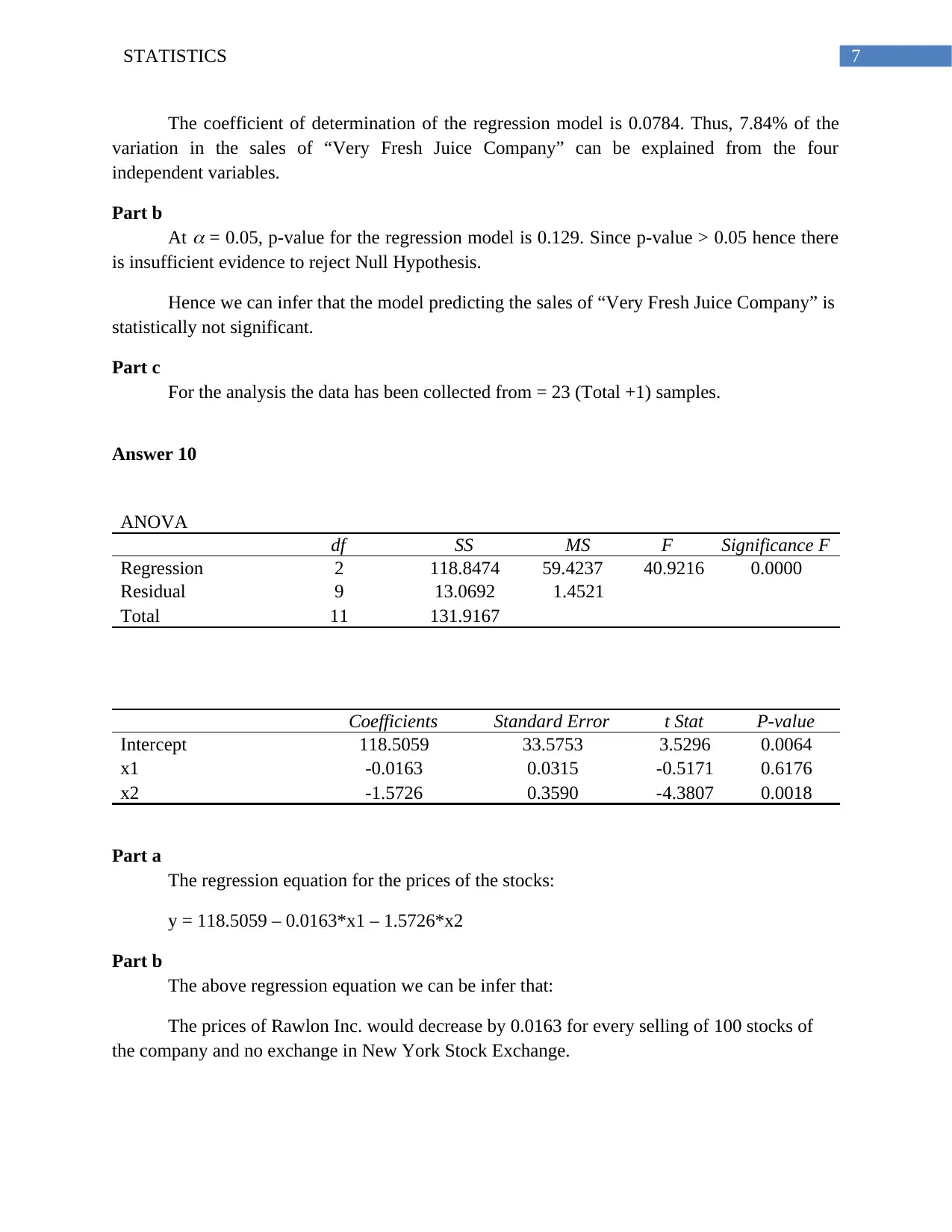
7STATISTICS
The coefficient of determination of the regression model is 0.0784. Thus, 7.84% of the
variation in the sales of “Very Fresh Juice Company” can be explained from the four
independent variables.
Part b
At
= 0.05, p-value for the regression model is 0.129. Since p-value > 0.05 hence there
is insufficient evidence to reject Null Hypothesis.
Hence we can infer that the model predicting the sales of “Very Fresh Juice Company” is
statistically not significant.
Part c
For the analysis the data has been collected from = 23 (Total +1) samples.
Answer 10
ANOVA
df SS MS F Significance F
Regression 2 118.8474 59.4237 40.9216 0.0000
Residual 9 13.0692 1.4521
Total 11 131.9167
Coefficients Standard Error t Stat P-value
Intercept 118.5059 33.5753 3.5296 0.0064
x1 -0.0163 0.0315 -0.5171 0.6176
x2 -1.5726 0.3590 -4.3807 0.0018
Part a
The regression equation for the prices of the stocks:
y = 118.5059 – 0.0163*x1 – 1.5726*x2
Part b
The above regression equation we can be infer that:
The prices of Rawlon Inc. would decrease by 0.0163 for every selling of 100 stocks of
the company and no exchange in New York Stock Exchange.
The coefficient of determination of the regression model is 0.0784. Thus, 7.84% of the
variation in the sales of “Very Fresh Juice Company” can be explained from the four
independent variables.
Part b
At
= 0.05, p-value for the regression model is 0.129. Since p-value > 0.05 hence there
is insufficient evidence to reject Null Hypothesis.
Hence we can infer that the model predicting the sales of “Very Fresh Juice Company” is
statistically not significant.
Part c
For the analysis the data has been collected from = 23 (Total +1) samples.
Answer 10
ANOVA
df SS MS F Significance F
Regression 2 118.8474 59.4237 40.9216 0.0000
Residual 9 13.0692 1.4521
Total 11 131.9167
Coefficients Standard Error t Stat P-value
Intercept 118.5059 33.5753 3.5296 0.0064
x1 -0.0163 0.0315 -0.5171 0.6176
x2 -1.5726 0.3590 -4.3807 0.0018
Part a
The regression equation for the prices of the stocks:
y = 118.5059 – 0.0163*x1 – 1.5726*x2
Part b
The above regression equation we can be infer that:
The prices of Rawlon Inc. would decrease by 0.0163 for every selling of 100 stocks of
the company and no exchange in New York Stock Exchange.
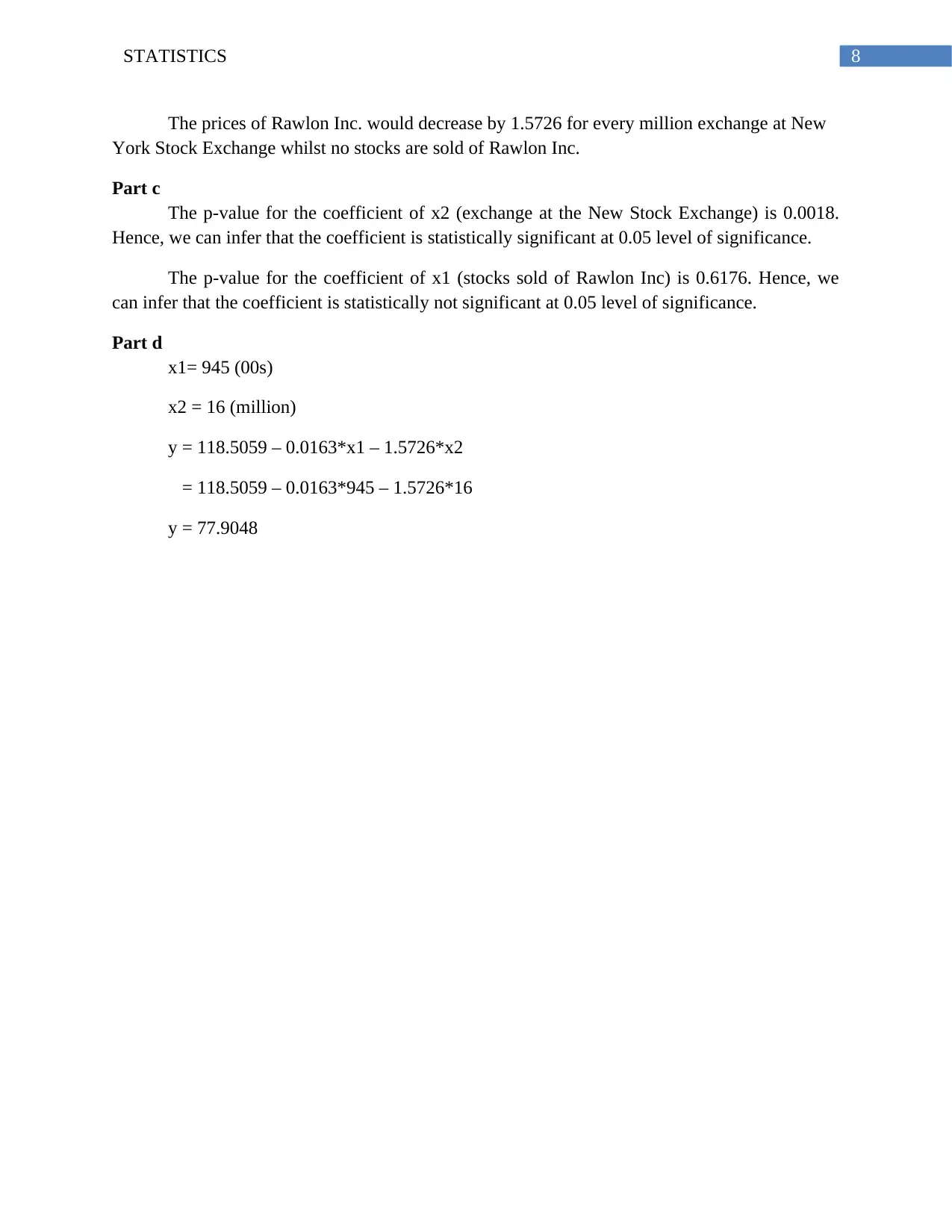
8STATISTICS
The prices of Rawlon Inc. would decrease by 1.5726 for every million exchange at New
York Stock Exchange whilst no stocks are sold of Rawlon Inc.
Part c
The p-value for the coefficient of x2 (exchange at the New Stock Exchange) is 0.0018.
Hence, we can infer that the coefficient is statistically significant at 0.05 level of significance.
The p-value for the coefficient of x1 (stocks sold of Rawlon Inc) is 0.6176. Hence, we
can infer that the coefficient is statistically not significant at 0.05 level of significance.
Part d
x1= 945 (00s)
x2 = 16 (million)
y = 118.5059 – 0.0163*x1 – 1.5726*x2
= 118.5059 – 0.0163*945 – 1.5726*16
y = 77.9048
The prices of Rawlon Inc. would decrease by 1.5726 for every million exchange at New
York Stock Exchange whilst no stocks are sold of Rawlon Inc.
Part c
The p-value for the coefficient of x2 (exchange at the New Stock Exchange) is 0.0018.
Hence, we can infer that the coefficient is statistically significant at 0.05 level of significance.
The p-value for the coefficient of x1 (stocks sold of Rawlon Inc) is 0.6176. Hence, we
can infer that the coefficient is statistically not significant at 0.05 level of significance.
Part d
x1= 945 (00s)
x2 = 16 (million)
y = 118.5059 – 0.0163*x1 – 1.5726*x2
= 118.5059 – 0.0163*945 – 1.5726*16
y = 77.9048
⊘ This is a preview!⊘
Do you want full access?
Subscribe today to unlock all pages.

Trusted by 1+ million students worldwide
1 out of 9
Related Documents
Your All-in-One AI-Powered Toolkit for Academic Success.
+13062052269
info@desklib.com
Available 24*7 on WhatsApp / Email
![[object Object]](/_next/static/media/star-bottom.7253800d.svg)
Unlock your academic potential
Copyright © 2020–2025 A2Z Services. All Rights Reserved. Developed and managed by ZUCOL.





